A music workstation is an electronic musical instrument providing the facilities of:
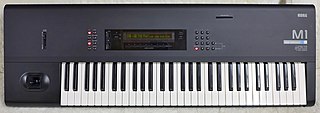
The Korg M1 is a synthesizer and music workstation manufactured by Korg from 1988 to 1995. It is the bestselling synthesizer in history, selling an estimated 250,000 units.
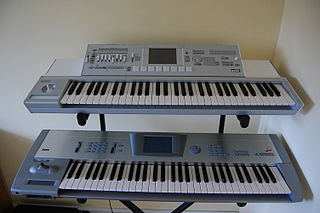
The Korg Triton is a music workstation synthesizer, featuring digital sampling and sequencing, released in 1999. It uses Korg's HI Synthesis tone generator and was eventually available in several model variants with numerous upgrade options. The Triton became renowned as a benchmark of keyboard technology, and has been widely featured in music videos and live concerts. At the NAMM 2007, Korg announced the Korg M3 as its successor.

The Korg OASYS is a workstation synthesizer released in early 2005, 1 year after the successful Korg Triton Extreme. Unlike the Triton series, the OASYS uses a custom Linux operating system that was designed to be arbitrarily expandable via software updates, with its functionality limited only by the PC-like hardware.
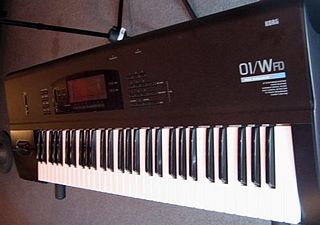
The Korg 01/W is a workstation synthesizer, released in 1991, and was intended to replace the M1 and T series. The workstation/ROMpler was based on AI², an improved version of the AI Synthesis technology found in the M1. The success of the AI² architecture ensured it was used in the majority of subsequent Korg synths of the 1990s.

The Korg Trinity is a synthesizer music workstation released by Korg in 1995. It was also the first workstation to offer modular expansion for not only sounds, but also studio-grade feature such as SCSI, ADAT, various sound engine processors, audio recording capability, and more. It was considered one of the most comprehensive music workstations, in term of features, at the time.
The Fantom-X (Xa/X6/X7/X8/XR) is a music workstation/synthesizer produced by Roland Corporation. It was introduced in 2004 as an upgrade from the Fantom S series. The Fantom-X competes with the Korg Triton/Triton Extreme, the Yamaha Motif ES and other similar large-scope keyboards such as the discontinued Alesis Fusion. In 2008 it was succeeded by the Fantom-G*, which was devised to compete with the new Korg and Yamaha flagship keyboards.
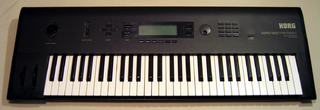
The Korg Wavestation is a vector synthesis synthesizer first produced in the early 1990s and later re-released as a software synthesizer in 2004. Its primary innovation was Wave Sequencing, a method of multi-timbral sound generation in which different PCM waveform data are played successively, resulting in continuously evolving sounds. The Wavestation's "Advanced Vector Synthesis" sound architecture resembled early vector synths such as the Sequential Circuits Prophet VS.

Korg M3 is a music workstation synthesizer manufactured by Korg Corporation and introduced at the Winter NAMM show during January, 2007, being released four months later. The M3 is the successor of the famous Triton series. The name is based on the former M1, which was considered a revolutionary synth at the time.
The Yamaha S80 is an 88-weighted-key synthesizer, produced by Yamaha Corporation.
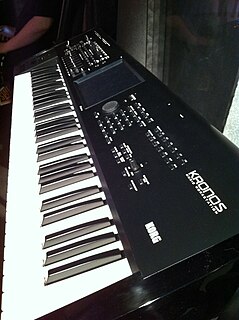
The Kronos is a music workstation manufactured by Korg that combines nine different synthesizer sound engines with a sequencer, digital recorder, effects, a color touchscreen display and a keyboard. Korg's latest flagship synthesizer series at the time of its announcement, the Kronos series was announced at the winter NAMM Show in Anaheim, California in January 2011.
Mini Pops was the name given to a number of early drum machines from the Japanese musical equipment company Korg during the late 1960s and the 1970s. The machines were based around a number of preset rhythm patterns, such as waltz, samba and rhumba.

The Korg OASYS PCI is a DSP-based PCI-card for PC and Mac released in 1999. It offers many synthesizer engines from sampling and substractive to FM and physical modelling. Because of it's high market price and low polyphony production was stopped in 2001. About 2000 cards were produced.
The RSF Kobol is a French monophonic synthesizer released in 1978. Described by purists as the French Minimoog. It could process external sounds to through the envelope and filter section. It was created by Ruben and Serge Fernandez. Fewer than 200 were made as they were not mass produced. At the time a possible alternative or addition to the Minimoog. The Kobol is a very versatile instrument, offering many sought after features of other analogue synthesizers of its time.
The Roland D-70 is a 76 note Super LA synthesizer produced in Japan in 1990. it featured a 240 x 64 pixel backlit LCD display and competed with the likes of the Korg M1 and T-series workstations and Yamaha SY77 workstation, although the D-70 was not itself a workstation because it lacked a sequencer. The D-70 can also split or layer the four tones that constitute a patch and has D-50 style TVF filters. It has onboard drums sounds and is 6-part multi timbral. It has four left control faders that can be assigned in real time to the following paramemeters: Level, Pan, Tuning, Cutoff, Resonance, Attack, and Release. It has three modes of play: Mono, Polyphonic, Split. Despite being anticipated as a "Super D-50", it is in fact a different machine, a prototype of very successful JV series full-sample playback synths (ROMplers). It's very similar to JV-90, though has fewer quality samples and fewer editing capabilities.
The Satellite is a lesser known monophonic analog synthesizer that was manufactured by Moog Music from 1973 to 1979 in response to the ARP Pro Soloist. It had one VCO. It was designed for use with any organ or sound system. The American company Thomas Organ bought the license to build it. The case is made out of wood.
The Kawai K1 is a 61 key synthesizer manufactured in 1988 by Kawai. It is an entry-level and low fidelity synthesizer and not as feature rich as the Kawai K4 and was released to compete with the Roland D50 and Korg M1 synthesizers. The patch memory can be doubled with a DC-8 memory card which was available separately.
The Korg Collection 2 is a collection of VST instruments from Korg and was released in 2004 with updates and more Synths added over time. The original 2004 release consists of the Korg MS-20, Korg Polysix and Korg Wavestation, and LegacyCell, a VST which layers combinations of any of the past 3 synths mentioned. In 2007, they added the Korg Mono/Poly, Korg M1, and Korg MDE-X Multi FX processor. On December 21, 2017, the ARP Odyssey was made into a VST and added to the collection, and the Korg Triton was added on for Christmas 2019. All of these synths were revamped in the spring of 2020 and renamed, collectively, the Korg Collection 2.
The miniKORG is a two VCO monophonic analog synthesizer that was released in 1972 from Korg. It featured 37 keys, three ring modulators and built in analogue effects. It has wooden side panels and all the controls for the unit are not on the front panel but on the side facing the player. It was considered to be stable, affordable and sounded great.









